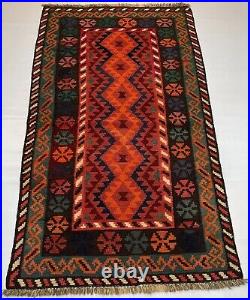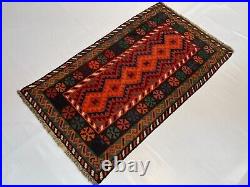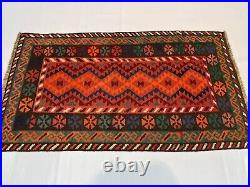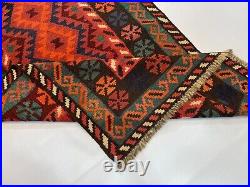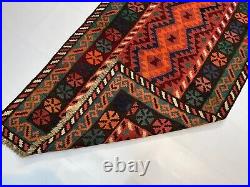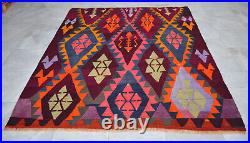
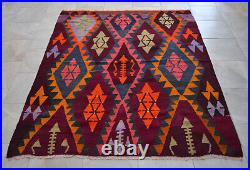

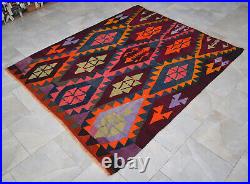
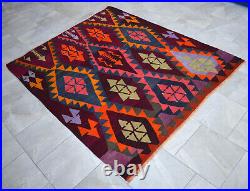
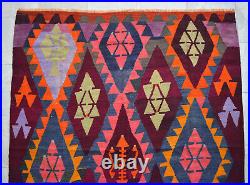

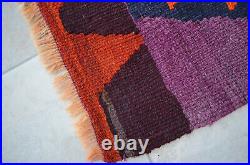
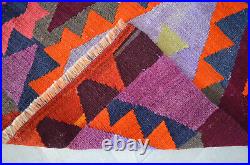



6×10 feet Hand woven Turkish Kilim Rug Antalya Barak. Dimensions : 70″ x 83″ Excluding fringe / Size metric : 180×212 cm Material : Made of wool on wool and natural dyes Condition: Rug is in good Condition. Please kindly note that; the image color may differ from the actual item colors and colors may differ from screen to screen. Please add me to your favorites list. Please check out my store. Types of carpets you can find in my store. Area rugs, rug, rugs, antique rug, vintage rug, turkish rug, kilim rug, kilim, oushak rug, 9×12 area rugs, vintage turkish rug, anatolian rug, large turkish rug, handmade turkish area rug, Vintage Wool Rug, Hand-knotted Tribal Carpet, Traditional Oriental Rug, Antique Rug, Turkish Rug, Hand made rug, Runner Carpet, Oushak Carpet, Ushak Rug, Ushak Carpet, Wool Carpet, Natural Wool Rug, Oriental Rug bohemian Rug Turkish Area Rug, Turkish Area Carpet, %100 wool Rug, Turkish Ushak Rug, Turkish Ushak carpet, Anatolian Rug, Anatolian Carpet, Oriental Antique Rugs & carpets, Turkish Antique Rugs & carpets, Geometric Antique Rugs & carpets, ethnic rug, handmade rug, decorative rugs, runner rug, Distressed Rugs, Low Pile Rugs, Oushak Design, Kilim Antique Rugs & carpets, Kilim rug, Runner Rug, Kurdish rug, Turkish Runner, Kurdish Runner Rug, Small rugs, Doormats, Wall Rugs, Antique Kilims, Colorful Rugs & carpets, Ushak Kilims, Oushak Rugs. Livingroom rug, Boho decor, Home decor, Rustic decor, Bohemian rug, Handmade rug, Silk rug, Livingroom rug, Turkey rug, 4×6 rug, 6×9 rug, Hallway rug, Bohemian rug, Bedroom rug, Dining room rug, rectangle rug, Square Rug, Round Rug, petite rug, ragrug, Extra long Runner, Palace Size Rugs, Over size Rugs and carpets, Stair runners, stair treads, square rugs, 6×6 Rugs. What is the Kilim (From Wikipedia) A kilim (Turkish: Kilim; Turkmen: Kilim; Azerbaijani: Kilim; Persian: Gilim) is a flat tapestry-woven carpet or rug traditionally produced in countries of the former Persian Empire, including Iran, the Balkans and the Turkic countries. Kilims can be purely decorative or can function as prayer rugs. Modern kilims are popular floor coverings in Western households. Etymology The term’kilim’ originates from the Persian galim where it means’to spread roughly’, perhaps of Akkadian or Aramean origin. Another name for Galim(Gilim) is Plas, Ferdowsi and other persian poet mentioned both Galim and plas as synonyms in Shahnameh No 35 mentioned as Plas(plus) No14 mentioned as Galim Like pile carpets, kilim have been produced since ancient times. The explorer Mark Aurel Stein found kilims dating to at least the fourth or fifth century CE in Hotan, China: As kilims are much less durable than rugs that have a pile to protect the warp and weft, it is not surprising that few of great age remain. Weaving technique Kilims are produced by tightly interweaving the warp and weft strands of the weave to produce a flat surface with no pile. Kilim weaves are tapestry weaves, technically weft-faced plain weaves, that is, the horizontal weft strands are pulled tightly downward so that they hide the vertical warp strands. Turkish kilim, folded to show slits between different coloured areas When the end of a color boundary is reached, the weft yarn is wound back from the boundary point. Thus, if the boundary of a field is a straight vertical line, a vertical slit forms between the two different color areas where they meet. For this reason, most kilims can be classed as “slit woven” textiles. The slits are beloved by collectors, as they produce very sharp-etched designs, emphasizing the geometry of the weave. Weaving strategies for avoiding slit formation, such as interlocking, produce a more blurred design image. The weft strands, which carry the visible design and color, are almost always wool, whereas the hidden warp strands can be either wool or cotton. The warp strands are only visible at the ends, where they emerge as the fringe. This fringe is usually tied in bunches, to ensure against loosening or unraveling of the weave. Motifs Many motifs are used in Turkish kilims, each with many variations. A few examples are illustrated here, with meanings as described by Güran Erbek in Kilim. A widely used motif is the elibelinde, a stylized female figure, motherhood and fertility. Other motifs express the tribal weavers’ desires for protection of their families’ flocks from wolves with the wolf’s mouth or the wolf’s foot motif (Turkish: Kurt Agzi, Kurt Izi), or for safety from the sting of the scorpion (Turkish: Akrep). Several motifs hope for the safety of the weaver’s family from the evil eye (Turkish: Nazarlik, also used as a motif), which could be divided into four with a cross symbol (Turkish: Haç), or averted with the symbol of a hook (Turkish: Çengel), a human eye (Turkish: Göz), or an amulet (Turkish: Muska; often, a triangular package containing a sacred verse). Such an amulet woven into a rug is not a picture of the thing itself: it actually is an amulet, believed to confer protection by its presence. Other motifs symbolised fertility, as with the trousseau chest motif (Turkish: Sandikli), or the explicit fertility (Turkish: Bereket,) motif. The motif for running water (Turkish: Su Yolu) similarly depicts the resource literally. The desire to tie a family or lovers together could be depicted with a fetter motif (Turkish: Bukagi). Several other motifs represented the desire for good luck and happiness, as for instance the bird (Turkish: Kus) and the star or Solomon’s seal (Turkish: Yildiz). The oriental symbol of Yin/Yang is used for love and unison (Turkish: Ask ve Birlesim). Anatolian (Turkish) Perhaps the best known and most highly regarded, these kilims are traditionally distinguished by the areas, villages or cities in which they are produced, such as Oushak (Usak – Usak), Konya, Malatya, Karapinar and Hotamis. Most Anatolian kilims are slit woven. Larger antique kilims were woven in two to three separate sections on small nomadic horizontal floor looms in three feet wide long strips, then carefully sewn together matching the patterns edges to create an ultimately wider rug. These pieces are still being produced in very limited quantities by nomadic tribes for their personal use and are commonly known as cicims. Cicim or Jijim or Jajim are kilims woven in narrow strips that are sewn together. Zili is a rough supplementary-weft method used to decorate practical objects such as mats, sacks, cushions and tents.


